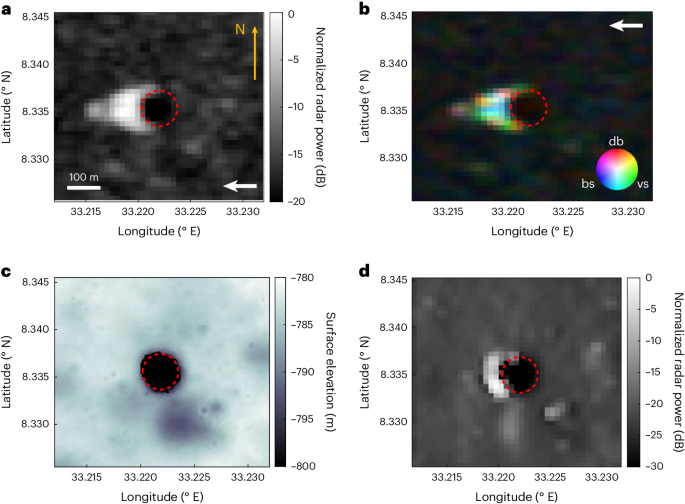Greeley, R. Lava tubes and channels in the lunar Marius Hills. Moon 3, 289–314 (1971).
Halliday & William, R. Terrestrial pseudokarst and the lunar topography. Bull. Natl Speleol. Soc. 28, 167–170 (1966).
Horz, F. in Lunar Bases and Space Activities of the 21st Century (ed. Mendell, W. W.) 405–412 (Lunar and Planetary Institute, 1985).
Haruyama, J. et al. Possible lunar lava tube skylight observed by SELENE cameras. Geophys. Res. Lett. https://doi.org/10.1029/2009GL040635 (2009).
Robinson, M. S. et al. Confirmation of sublunarean voids and thin layering in mare deposits. Planet. Space Sci. 69, 18–27 (2012).
Wagner, R. V. & Robinson, M. S. Distribution, formation mechanisms, and significance of lunar pits. Icarus 237, 52–60 (2014).
Kaku, T. et al. Detection of intact lava tubes at Marius Hills on the Moon by SELENE (Kaguya) Lunar Radar Sounder. Geophys. Res. Lett. 44, 10–155 (2017).
Donini, E., Carrer, L., Gerekos, C., Bruzzone, L. & Bovolo, F. An unsupervised fuzzy system for the automatic detection of candidate lava tubes in radar sounder data. IEEE Trans. Geosci. Remote Sens. TGRS.2021.3062753 (2021).
Chappaz, L. et al. Evidence of large empty lava tubes on the Moon using GRAIL gravity. Geophys. Res. Lett. 44, 105–112 (2017).
Horvath, T., Hayne, P. O. & Paige, D. A. Thermal and illumination environments of lunar pits and caves: models and observations from the Diviner Lunar Radiometer experiment. Geophys. Res. Lett. 49, e2022GL099710 (2022).
Kobayashi, T., Kim, J. H., Lee, S. R. & Song, K. Y. Nadir detection of lunar lava tube by Kaguya lunar radar sounder. IEEE Trans. Geosci. Remote Sens. 59, 7395–7418 (2020).
Nesnas, I. A. et al. Moon diver: exploring a pit’s exposed strata to understand lunar volcanism. Acta Astronaut. 211, 163–176 (2023).
Haruyama, J. et al. in Moon: Prospective Energy and Material Resources (ed. Badescu, V.) 139–163 (Springer, 2012).
Carrer, L., Castelletti, D., Pozzobon, R., Sauro, F. & Bruzzone, L. A novel method for hidden natural caves characterization and accessibility assessment from spaceborne VHR SAR images. IEEE Trans. Geosci. Remote Sens. 61, 1–11 (2022).
Nozette, S. et al. The Lunar Reconnaissance Orbiter miniature radio frequency (Mini-RF) technology demonstration. Space Sci. Rev. 150, 285–302 (2010).
Raney, R. K. et al. The lunar mini-RF radars: hybrid polarimetric architecture and initial results. Proc. IEEE 99, 808–823 (2010).
Wagner, R. V. & Robinson, M. S. Lunar pit morphology: implications for exploration. J. Geophys. Res.: Planets 127, e2022JE007328 (2022).
Staid, M. I., Pieters, C. M. & Head, J. W. III Mare Tranquillitatis: basalt emplacement history and relation to lunar samples. J. Geophys. Res.: Planets 101, 23213–23228 (1996).
Wagner, R. V. & Robinson, M. S. Occurrence and origin of lunar pits: observations from a new catalog. In Proc. 52nd Lunar and Planetary Science Conference (Lunar and Planetary Institute, 2021).
Wynne, J. J. et al. Planetary caves: a Solar System view of processes and products. J. Geophys. Res.: Planets 127, e2022JE007303 (2022).
Cushing, G. E. Candidate cave entrances on Mars. J. Cave Karst Stud. 74, 33–47 (2012).
Sharma, R. & Srivastava, N. Detection and classification of potential caves on the flank of Elysium Mons, Mars. Res. Astron. Astrophys. 22, 065008 (2022).
Henriksen, M. R. et al. Extracting accurate and precise topography from LROC narrow angle camera stereo observations. Icarus 283, 122–137 (2017).
Auer, S., Hinz, S. & Bamler, R. Ray-tracing simulation techniques for understanding high-resolution SAR images. IEEE Trans. Geosci. Remote Sens. 48, 1445–1456 (2009).
Head, J. W. III. Lunar volcanism in space and time. Rev. Geophys. 14, 265–300 (1976).
Titus, T. N. et al. A roadmap for planetary caves science and exploration. Nat. Astron. 5, 524–525 (2021).
Blank, J. G. et al. Planetary Caves as Astrobiology Targets. White Paper (National Academy of Sciences, 2018).
Carrer, L. et al. Dataset of ‘Radar evidence of an accessible cave conduit on the Moon below the Mare Tranquillitatis pit’. Zenodo https://doi.org/10.5281/zenodo.11005458 (2024).

